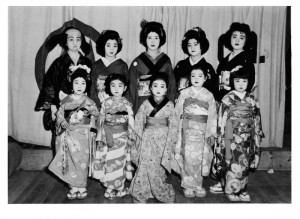Most documents and research on the internment camps for Japanese-Americans during World War II focus on the political situation of that time, the harsh conditions within the camps, and the forced “Americanization” of the inmates. However, there remains an untold story of how Japanese traditional performing arts survived and were even practiced in the camps, despite the political environment of that time.
Shirley Kazuyo Muramoto-Wong, a Japanese-American koto instructor based in California, has spent the last 20 years tracking down, researching, and recording the stories of students and teachers of such arts as koto, shamisen, and kabuki, who kept Japanese tradition alive in the face of hardship. Her journey started when she discovered that her mother, also a koto player, learned how to play the 6-foot long instrument in the Topaz and Tule Lake camps, despite the fact that internees were only allowed to bring in what they could carry.
Her upcoming documentary, made with Pauline L. Fong and independent filmmaker Joshua Fong, “Hidden Legacy: Japanese Traditional Performing Arts in the World War II Internment Camps,” explores how such traditional arts managed to flourish.
“During WWII when 120, 000 Japanese and Japanese-Americans were put into these 10 camps, all of a sudden, there was a concentration of all the Japanese in one place!” wrote Muramoto in an e-mail. “Even though organizations such as the JACL [Japanese American Citizens League] working with the federal government, were trying to get Japanese-Americans to assimilate into American culture, the situation actually stimulated the practice of Japanese cultural activities.”
Although most people would imagine that the authorities running the internment camps would discourage, even stamp out, Japanese culture, that was not exactly the case. In fact, the inmates had the freedom to practice Japanese arts within the camps, depending on the individual WRA (War Relocation Authority) administration overseeing them, as evident from a letter written by an Issei shakuhachi–a type of bamboo flute–performer, Kitaro Nyohyo Tamada:
“The WRA does not intend to promote ideals and cultures of nations with which we are at war, so long as patriotic music is not played. Japanese music may be played in the center but it will not be sponsored by the government. Paid teacher or special room or quarters cannot be provided for them.”
That very month, a Japanese traditional concert was held at the camp where Tamada was incarcerated.
“Most of the WRA authorities also recognized that if they did not allow their prisoners to keep themselves occupied, they would become stressed and even violent, so they allowed Japanese cultural activities to go on,” said Muramoto.

For Muramoto, tracking down all of these performers and teachers was not an overnight task. Some have already passed away while others may find it too painful to open up about a traumatic experience in their lives. Even Muramoto’s mother has refused to speak on camera. Most of the people interviewed were Nisei, second-generation Americans who are younger and much less traumatized than their older relatives who lost everything. On the other hand, some were able to open up since the experience happened more than 70 years ago, enough time for some wounds to heal.
“Some people, I did have to work to gain their trust before they would be comfortable talking to me, but I think it’s totally understandable that they would be reluctant to talk about that painful period in their lives,” said Muramoto.
Some of the artists who came forward to be interviewed were concerned that the arts they practice and their cultural traditions would die out with them. With widespread interest over aspects of Japanese culture such as anime and sushi, Muramoto believes that such a thing would not happen but does not dismiss the idea.
“Other cultures, such as the Native American culture, who have had their civilizations and arts run over with the taking of their lands, are losing their cultural arts and languages every day. These kinds of arts may not survive. That’s why I advocate that if a person feels something for a particular art, that they should pursue it, even if it is not of their blood heritage. This will ensure that it stays alive, that it will survive a little longer,” she said.
The upcoming documentary fills in some of the gaps that scholarly work, which mainly focuses on the political aspects of the internment or assimilation of Japanese-Americans so that they could be more “American,” has failed to cover. Up until now, the only scholarly work found by Muramoto is by Minamo Waseda, a professor at Tokyo Geijutsu Daigaku, who wrote a piece called, “Extraordinary Circumstances, Exceptional Practices: Music in Japanese American Concentration Camps.”
The film is almost completed, according to Muramoto, but they lack the necessary funds to cover fees such as post-production costs, music clearances, and DVD manufacturing. Funds are being raised on Indiegogo until April 23, 2014 and those who donate can receive perks such as a koto lesson from Muramoto herself. Showing times will be uploaded on the documentary’s website as they are decided.
